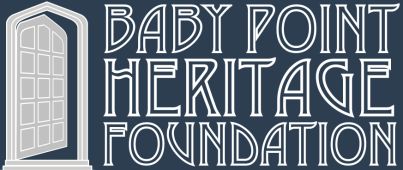Baby Point Heritage Attributes as outlined by the City of Toronto HCD Study (link to full study below)
- Baby Point was the site of indigenous use dating back thousands of years, including the Seneca village of Teiaiagon – one of the few known indigenous villages within present-day Toronto. The Toronto Carrying Place Trail, an important trade and transportation route between Lake Ontario and Lake Simcoe and a National Historic Event, is associated with this site.
- Baby Point also has strong associations with Toronto’s French history – French explorers and missionaries are known to have visited Teiaiagon and used the Carrying Place Trail, an early French trading post may have been built on the site, and the point was later the estate of James Baby, a prominent landowner and government official.
- The boundary includes three City-owned parks that were donated by Home Smith to provide ample green space for the residents of Baby Point along the banks of the Humber River.
Heritage attributes are the physical, spatial and material elements within the district that convey its heritage character and that should be conserved. They include buildings, streets and open spaces that are a collective asset to the community. Heritage attributes can range from physical features, such as building materials or architectural motifs, to overall spatial patterns, such as street layout and topography.
Historical and Associative Attributes
These attributes are important features that convey the history of the district, from its indigenous use through to its development as a planned garden suburb
- The plan of the neighbourhood which exemplifies garden suburb design principles as envisioned by Robert Home Smith
- The Baby Point Archaeologically Sensitive Area, associated with the district’s ancient indigenous and later European uses
- The historic Seneca village of Teiaiagon and its potential archaeological remains
Contextual, Social and Community Attributes
These attributes support a sense of place, defining the context of Baby Point and its community values
- The district’s historically strategic location atop a promontory adjacent to and overlooking the Humber River
- The Baby Point Gates, which mark a formal entrance into the neighbourhood from Jane Street
- 1 Baby Point Road, the former residence of Robert Home Smith and one of the neighbourhood’s first houses
- The Baby Point Club, a community and social hub founded by the neighbourhood’s early residents
- Humbercrest United Church, an important neighbourhood institution and community landmark
Design and Physical Attributes
These attributes reflect the design of Baby Point as a garden suburb, guided by a set of principles that informed the streetscape and architecture of the neighbourhood
- The curvilinear street pattern, that follows and reflects the natural topography
- The undulating pattern of houses that are sited and setback from the road, resulting in large landscaped yards and contributing to a park-like setting
- The predominantly low-rise scale of houses, generally 2-2.5 storeys tall
- The general use of brick, stone and stucco
- the consistency of early 20th century architectural styles, namely English Cottage (with Tudor influence) and Colonial Revival (with Georgian and Edwardian influence)
Natural Attributes
These attributes represent valued and unique natural resources that reflect the history of the district and contribute to a sense of place
- Magwood, Etienne Brule and Cashman Parks, and the Humber River – a designated Canadian Heritage River – which provide a green edge to the neighbourhood
- The landscaped front yards, with deep setbacks and extensive soft landscaping
- The extensive mature tree canopy, much of which predates the neighbourhood’s residential development and was purposefully conserved
